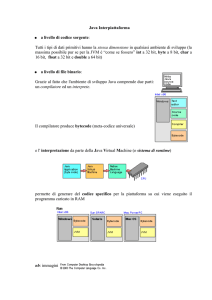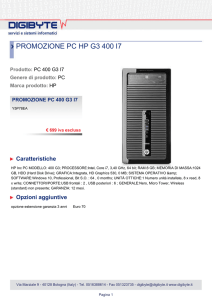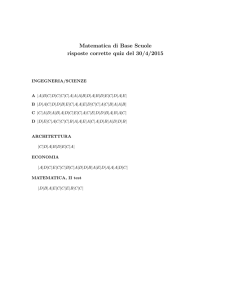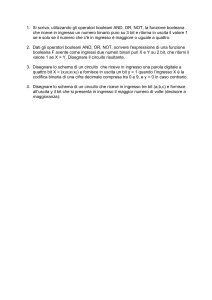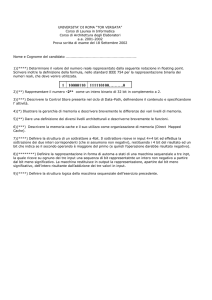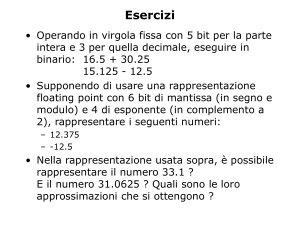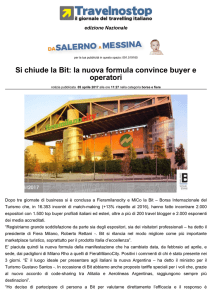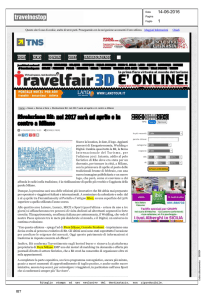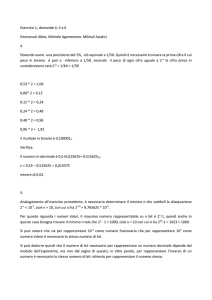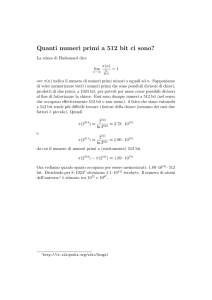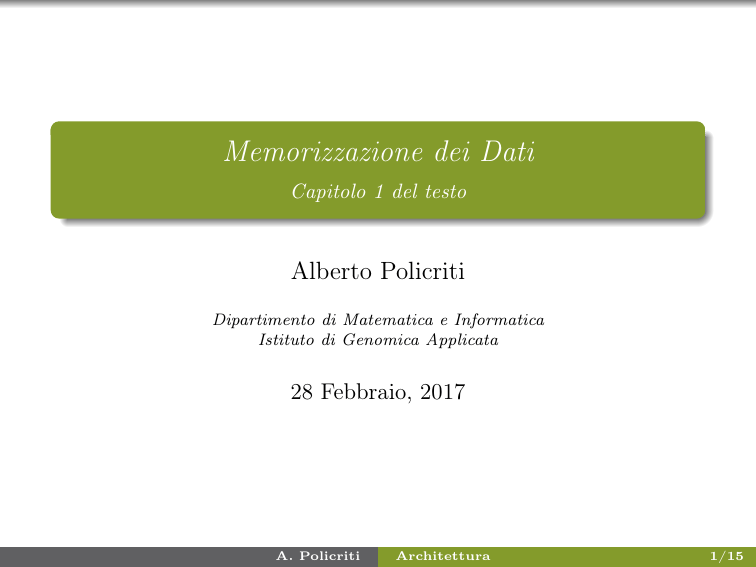
Memorizzazione dei Dati
Capitolo 1 del testo
Alberto Policriti
Dipartimento di Matematica e Informatica
Istituto di Genomica Applicata
28 Febbraio, 2017
A. Policriti
Architettura
1/15
La nozione fondamentale
Bits
Binary Digits
numeri,
cifre in base 2,
simboli,
acceso/spento,
si/no,
vero/falso,
...
Stringhe
stringhe di bits ⇒ stringhe in un alfabeto di 2 caratteri ⇒ ...
stringhe in un alfabeto di 4 caratteri ⇒ DNA
A. Policriti
Architettura
2/15
technologies such as gears, relays, and optic devices. Inside today’s computers,
gates are
usually implemented as small electronic circuits in which the digits 0
Calcolo
Proposizionale
and 1 are represented as voltage levels. We need not concern ourselves with such
details, however. For our purposes, it suffices to represent gates in their symbolic
Operazioni Booleane
AND
OR NOT XOR IF-THEN
Figure 1.1 The Boolean operations AND, OR, and XOR (exclusive or)
etc.
The AND operation
0
AND 0
0
0
AND 1
0
1
AND 0
0
1
AND 1
1
The OR operation
OR
0
0
0
OR
0
1
1
OR
1
0
1
OR
1
1
1
The XOR operation
0
XOR 0
0
0
XOR 1
1
A. Policriti
1
XOR 0
1
Architettura
1
XOR 1
0
3/15
to shift to the other value. In other words, the output will flip or flop between two
values under control of external stimuli. As long as both inputs in the circuit in
Figure 1.3 remain 0, the output (whether 0 or 1) will not change. However, temporarily placing a 1 on the upper input will force the output to be 1, whereas temporarily placing a 1 on the lower input will force the output to be 0.
Let us consider this claim in more detail. Without knowing the current output
of the circuit in Figure 1.3, suppose that the upper input is changed to 1 while the
lower input remains 0 (Figure 1.4a). This will cause the output of the OR gate to
be 1, regardless of the other input to this gate. In turn, both inputs to the AND
gate will now be 1, since the other input to this gate is already 1 (the output produced by the NOT gate whenever the lower input of the flip-flop is at 0). The output of the AND gate will then become 1, which means that the second input to
Circuiti: HW per il Caclolo Proposizionale
Porte (logiche)—gates
Realizzazioni in hardware degli operatori del calcolo
proposizionale.
Figure 1.2 A pictorial representation of AND, OR, XOR, and NOT gates as well as their input
and output values
AND
OR
Inputs
Output
Inputs
0
0
1
1
0
1
0
1
Inputs
Output
Output
Inputs
0
0
0
1
0
0
1
1
XOR
0
1
0
1
Output
0
1
1
1
NOT
Inputs
Output
Inputs
0
0
1
1
0
1
0
1
Inputs
Output
Output
Inputs
Output
0
1
1
0
0
1
1
0
A. Policriti
Architettura
4/15
Circuiti: HW per il Caclolo Proposizionale
the OR gate will now be 1 (Figure 1.4b). This guarantees that the output of the
OR gate will remain 1, even when the upper input to the flip-flop is changed
back to 0 (Figure 1.4c). In summary, the flip-flop’s output has become 1, and this
output value will remain after the upper input returns to 0.
In a similar manner, temporarily placing the value 1 on the lower input will
force the flip-flop’s output to be 0, and this output will persist after the input
value returns to 0.
Memorizzazione di un bit di informazione: flip-flop
Realizzazione in hardware della memoria per 1 bit.
Figure 1.4 Setting the output of a flip-flop to 1
a. 1 is placed on the upper input.
b. This causes the output of the OR gate to be 1 and,
in turn, the output of the AND gate to be 1.
1
1
1
1
1
1
0
0
c. The 1 from the AND gate keeps the OR gate from
changing after the upper input returns to 0.
0
1
1
1
1
0
A. Policriti
Architettura
4/15
Circuiti: HW per il Caclolo Proposizionale
Flip-Flop
1 Combinando porte ottengo circuiti che hanno
comportamenti complessi (memoria).
2
Una volta costruito il circuito non mi interesso più ai
dettagli: astrazione.
3
Tanti circuiti tanta potenza (in poco spazio: Very Large
Scale Integration—VLSI—, computers on a chip)
A. Policriti
Architettura
4/15
Hexadecimal Notation
Circuiti:
HWtheper
ilactivities
Caclolo
Proposizionale
When considering
internal
of a computer,
we must deal with patterns of bits, which we will refer to as a string of bits, some of which can be quite
long. A long string of bits is often called a stream. Unfortunately, streams are
difficult for the human mind to comprehend. Merely transcribing the pattern
101101010011 is tedious and error prone. To simplify the representation of such
bit patterns, therefore, we usually use a shorthand notation called hexadecimal
Esercizio:
untakes
altro
modo
difact
implementare
un flip-flop
notation, which
advantage
of the
that bit patterns within
a machine
(in realtà non vengono implementati né così né come prima).
Figure 1.5 Another way of constructing a flip-flop
Input
Output
Input
A. Policriti
Architettura
4/15
Dai bit alle informazioni
Stringhe, Pattern, Stream, ... di bits
Idea (vecchia): cambiamo base—i.e. introduciamo nuovi simboli
che corrispondono a stringhe di bit.
Esempio
1.1 Bits and Their Storage
25
La codifica dei numeri naturali in base 16 (hexadecimal
encoding
system):
Figure 1.6 The hexadecimal encoding system
notation, which takes advantage of the fact that bit patterns within a machine
tend to have lengths
of four. In particular,
hexadecimal notation uses
A.in multiples
Policriti
Architettura
5/15
Memoria Principale: RAM
A. Policriti
(Random Access Memory)
Architettura
6/15
Memoria Principale: RAM
(Random Access Memory)
Terminologia
main memory: hw per memorizzare tutti i bit che mi servono
durante il calcolo (... “tanti flip-flop”);
1.2 Main Memory
27
Figure 1.7 The organization of a byte-size memory cell
1
0
High-order end
0
1
1
0
1
0
Low-order end
cella di memoria: collezioni di bit (normalmente 8) che vengono
manipolati insieme;
1.2 Main Memory
27
Most
significant
bit
byte: 8 bit;
Figure 1.7
Least
significant
bit
Although there is no left or right within a computer, we normally envision the
bits within a memory cell as being arranged in a row. The left end of this row is
called the high-order end, and the right end is called the low-order end. The leftmost bit is called either the high-order bit or the most significant bit in reference
The organization
of contents
a byte-size
memory
cell as representing a numeric
to the fact that if the
of the cell
were interpreted
value, this bit would be the most significant digit in the number. Similarly, the rightmost bit is referred to as the low-order bit or the least significant bit. Thus we may
represent the contents of a byte-size memory cell as shown in Figure 1.7.
1
0
1
1
0
1
0
0
High-order
end
Low-order end
To identify individual cells in a computer’s main memory, each cell is
assigned a unique “name,” called its address. The system is analogous to the technique of identifying houses in a city by addresses. In the case of memory cells,
however, the addresses used are entirely numeric. To be more precise, we enviMost
Least
sion all the cells
being placed in a single row and numbered in
this order starting
significant
with the value
zero. Such an addressing system not only significant
gives us a way of
uniquely identifying
bit each cell but also associates an order to the
bitcells (Figure 1.8),
giving us phrases such as “the next cell” or “the previous cell.”
An important consequence of assigning an order to both the cells in main
memory and the bits within each cell is that the entire collection of bits within a
computer’s main memory is essentially ordered in one long row. Pieces of this
long row can therefore be used to store bit patterns that may be longer than the
length of a single cell. In particular, we can still store a string of 16 bits merely by
using two consecutive memory cells.
To complete the main memory of a computer, the circuitry that actually
holds the bits is combined with the circuitry required to allow other circuits to
Although there is no left or right within a computer, we normally envision the
bits within
a memory
cell as
arranged in a della
row. The left
end of nella
this row islista delle
indirizzo (di
una
cella)
: being
posizione
cella
called the high-order end, and the right end is called the low-order end. The leftmost bit is called either the high-order bit or the most significant bit in reference
celle:
Figure 1.8 Memory cells arranged by address
to the fact that if the contents of the cell were interpreted as representing a numeric
value, this bit would be the most significant digit in the number. Similarly, the rightmost bit is referred to as the low-order bit or the least significant bit. Thus we may
represent the contents of a byte-size memory cell as shown in Figure 1.7.
To identify individual cells in a computer’s main memory, each cell is
assigned a unique “name,” called its address. The system is analogous to the technique of identifying houses in a city by addresses. In the case of memory cells,
however, the addresses used are entirely numeric. To be more precise, we envision all the cells being placed in a single row and numbered in this order starting
with the value zero. Such an addressing system not only gives us a way of
uniquely identifying each cell but also associates an order to the cells (Figure 1.8),
giving us phrases such as “the next cell” or “the previous cell.”
A. Policriti
Architettura
An important consequence of assigning an order to both the cells in main
1011
0001
1110
1000
01
10
0010
Cel
0011
0111
l9
1110
l 11
Cel
l 10
Cel
Cel
0111
1111
0001
l8
Cel
l7
l6
Cel
1011
00
01
l5
Cel
1010
0001
l4
Cel
0101
1110
l3
Cel
0110
1101
l2
Cel
1000
1101
l1
Cel
1011
1010
l0
Cel
6/15
Memoria Principale: RAM
(Random Access Memory)
Questions & Exer
1. If the memory cell whose address is 5 contains the value 8, what is the
difference between writing the value 5 into cell number 6 and moving
the contents of cell number 5 into cell number 6?
2. Suppose you want to interchange the values stored in memory cells 2 and
3. What is wrong with the following sequence of steps:
Step 1. Move the contents of cell number 2 to cell number 3.
Step 2. Move the contents of cell number 3 to cell number 2.
Design a sequence of steps that correctly interchanges the contents of
these cells. If needed, you may use additional cells.
3. How many bits would be in the memory of a computer with 4KB memory?
1.3 Mass Storage
Due to the volatility and limited size of a computer’s main memory, most computers have additional memory devices called mass storage (or secondary storage)
systems, including magnetic disks, CDs, DVDs, magnetic tapes, flash drives, and
solid-state disks (all of which we will discuss shortly). The advantages of mass
A. Policriti
storage systems over main memory
includeArchitettura
less volatility, large storage capaci-
6/15
Memoria Principale: RAM
(Random Access Memory)
I dati (le celle) sono ordinati
Posso parlare non solo della cella che si trova ad un dato
indirizzo, ma anche della cella che viene dopo/prima ...
Posso memorizzare stringhe lunghe usando celle consecutive
RAM
Posso accedere ad una cella qualunque semplicemente
specificandone l’indirizzo
DRAM: Dynamic RAM (refresh)
SDRAM: Synchronous DRAM (synchronous refresh)
A. Policriti
Architettura
6/15
Misuriamo
1 bit: 2 informazioni
2 bit: 4 informazioni
3 bit: 8 informazioni
...
8 bit: 256 informazioni ⇒ un byte B.
A. Policriti
Architettura
7/15
Misuriamo
Kilo byte: 210 = 1024 B
Mega byte: 210 = 1024 K
Giga byte: 210 = 1024 M
Tera byte: 210 = 1024 G
Peta byte: 210 = 1024 T
...
Convenzioni
Memoria in byte.
Banda di trasmissione in bit.
A. Policriti
Architettura
7/15
Memoria Secondaria
Memorie di massa: memoria non volatile
On-line and Off-line
Memorie lente. Spesso richiedono (addirittura) movimenti di
parti meccaniche.
Solid-state vs. mechanical
A. Policriti
Architettura
8/15
Memoria Secondaria
Esempi
dischi magnetici
CD
DVD
nastri magnetici
flash drives
A. Policriti
Architettura
8/15
placed above and/or below the disk so that as the disk spins, each head traverses
a circle, called a track. By repositioning the read/write heads, different concenMemoria
Secondaria
tric tracks
can be accessed. In many cases, a disk storage system consists of sev-
eral disks mounted on a common spindle, one on top of the other, with enough
space for the read/write heads to slip between the platters. In such cases, the
Dischi Magnetici
Figure 1.9 A disk storage system
Track divided
into sectors
Disk
Read/write head
Access arm
Arm motion
Disk motion
Tecnologicamente molto sofisticati (e.g. coated, zoned)
cilindri
seek time
settori
latency time
formattazione
acess time
A. Policriti
Architettura
8/15
Another class of mass storage systems applies optical technology. An example is
the compact disk (CD). These disks are 12 centimeters (approximately 5 inches)
Memoria
Secondaria
in diameter
and consist of reflective material covered with a clear protective
coating. Information is recorded on them by creating variations in their reflective
Nastri Magnetici
Figure 1.10 A magnetic tape storage mechanism
Tape reel
Take-up reel
Read/write
head
Tape
Tape
Tape motion
Basso transfer rate (associato ad ogni tecnologia)
Molti fattori coinvolti.
Molte tecniche per miglioralo.
Dell’ordine dei MB al secondo
A. Policriti
Architettura
8/15
focused laser, provide storage capacities of several GB. Such disks are capable of
storingottici
lengthy multimedia presentations, including entire motion pictures.
Sistemi
Finally, Blu-ray technology, which uses a laser in the blue-violet spectrum of
light (instead of red), is able to focus its laser beam with very fine precision. As a
Compact
Disks
Figure 1.11 CD storage format
Data recorded on a single track,
consisting of individual sectors,
that spirals toward the outer edge
CD
Disk motion
Digital Versatile Disks e Blu-ray Disks
DVD: superfici sovrapposte con diversi fuochi
BD: usano la parte blu dello spettro della luce
A. Policriti
Architettura
9/15
Flash Drives
SSD: niente più parti in movimento!
Spedisco segnali e memorizzo informazioni intrappolando
elettroni.
In linea di principio dovrebbero funzionale come delle RAM
ma le tecnologie di oggi consentono solo il trasferimento di
(grossi) blocchi di dati.
Non hanno una vita molto lunga.
Varianti
1 Secure Digital memory cards (SD)
2
Secure Digital High Capacity memory cards (SDHC)
3
Secure Digital Extended Capacity memory cards (SDXC,
attivano ai TB!)
A. Policriti
Architettura
10/15
Files
Cos’è un file?
Formalmente si definisce come una:
unità concettuale di memoria di massa
Definizioni (usiamo l’inglese)
physical record blocco minimo trasferibile dalla
tecnologia utilizzata per la memorizzazione dei dati
logical record blocco naturalmente definibile in funzione
del tipo di dati memorizzati
field sotto-unità dei record logici
chiave campo identificativo (ci ritorneremo parlando di
basi di dati)
buffer (in questo caso) regione della RAM usata per
contenere adeguate quantità di record fisici e per indirizzare
record logici
A. Policriti
Architettura
11/15
An area of memory used in this manner is called a buffer. In general, a
Files
buffer is a storage area used to hold data on a temporary basis, usually during the
process of being transferred from one device to another. For example, modern
Figure 1.12 Logical records versus physical records on a disk
Logical records correspond
to natural divisions within the data
Physical records correspond
to the size of a sector
A. Policriti
Architettura
11/15
Rappresentazione dei dati: testo
American National Standards Institute (ANSI)
Caratteri: codice ASCII
American Standard Code for Information Interchange:
7 bit: 128 combinazioni
codifico lettere maiuscole, minuscole e digit da 0 a 9 ....
Non è l’unico codice ma l’idea è sempre la stessa.
International Organization for Standardization (ISO)
Unicode (65.536 stringhe di bit)
A. Policriti
Architettura
12/15
Rappresentazione dei dati: testo
La tabella:
A. Policriti
Architettura
12/15
Rappresentazione dei dati: testo
Esercizio
Che differenza c’è tra la rappresentazione di
124924596
come testo o come numero?
A. Policriti
Architettura
12/15
Rappresentazione dei dati: testo
Text files
text editors
word processors
A. Policriti
Architettura
12/15
Rappresentazione dei valori numerici
Dati numerici
Numeri naturali: (semplice) rappresentazione binaria.
Numeri interi: uso il primo bit per il segno.
Numeri reali:
virgola fissa: un intero (parte intera) ed un razionale (parte
decimale);
virgola mobile: mantissa ed esponente.
A. Policriti
Architettura
13/15
Rappresentazione di immagini e suoni
Pixel (Picture element)
bit map: un pixel un(o o più) bit(s)
ok per printer e schermi,
un pixel può essere 0/1 o un valore numerico (scala di grigi,
RGB, ...),
problematico se dobbiamo riscalare l’immagine;
rappresentazione vettoriale: l’immagine è rappresentata
come collezione di oggetti geometrici ed il dispositivo
“decide” come rappresentarla (deve essere in grado di farlo ⇒ CPU)
TrueType (Microsoft and Apple per i caratteri)
PostScript (Adobe Systems per i caratteri e non solo)
A. Policriti
Architettura
14/15
Rappresentazione di immagini e suoni
Suono
ampiezze d’onda
MIDI (Musical Instrument Digital Interface)
A. Policriti
Architettura
14/15
Rappresentazione delle Istruzioni
Le istruzioni sono rappresentate come ...
... sequenze di bit costituite da due parti:
Codice Operativo
Operando
Che operazione voglio eseguire? Su quali dati?
A. Policriti
Architettura
15/15

